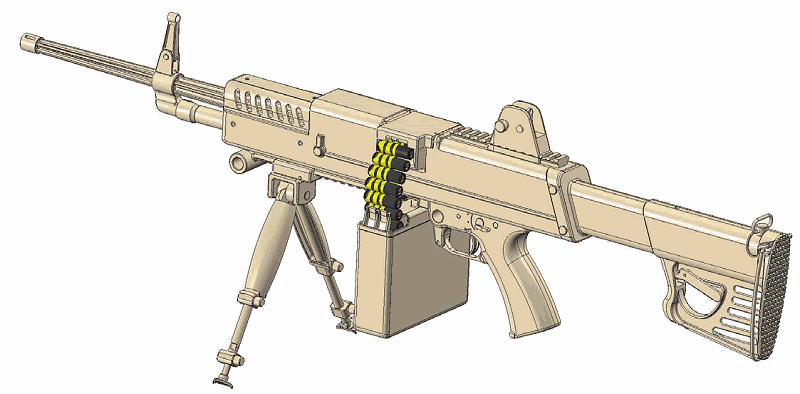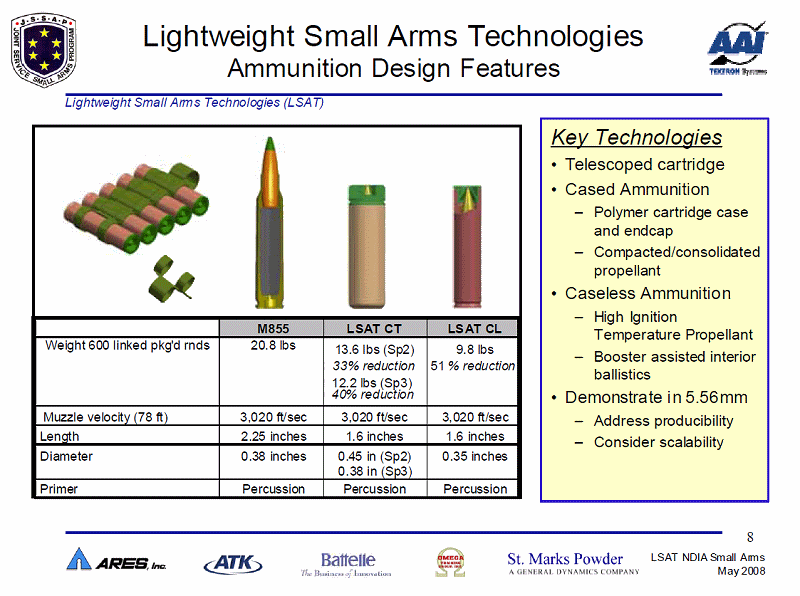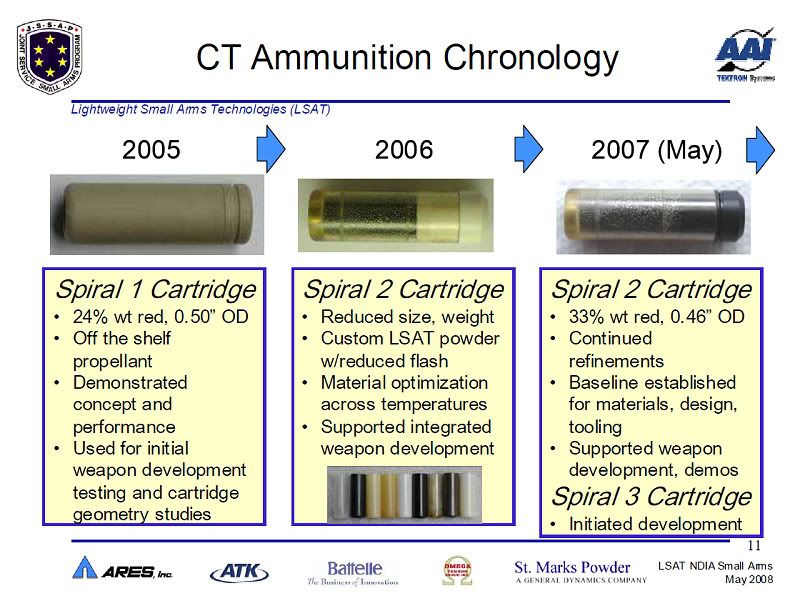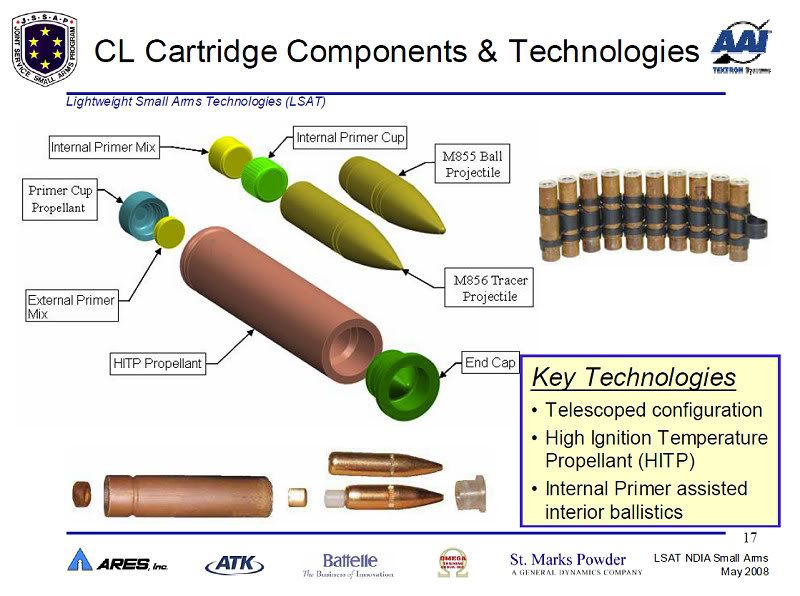I can't help but think that an SMG would be better than a really short SBR (under 10"). Even with heavy grain ammunition, 5.56 will fragment very poorly (not to mention increased muzzle blast, flash and perceived recoil). What about 5.45?
I think the Army will hold off procurement of a new carbine until the LSAT polymer telescope case ammuntion is either ready for use, or rejected.
New Ammo Slashes Machine Gun Weight
Army Engineers at the Picatinny Arsenal, N.J.-based Joint Service Small Arms Program office have been working for the last six years on a radical approach to ammunition and weapons that has the potential to cut the weight Soldiers carry by nearly 50 percent.
Researchers are using so-called "cased telescoped" ammunition that does away with the propellant-holding brass shell and replaces it with a lightweight plastic case. So far the program, dubbed Lightweight Small Arms Technologies, has built three M-249 Squad Automatic Weapon-like machine guns and fired more than 10,000 of the lighter rounds with the same rate of fire and accuracy of a standard SAW.
"This delivers the same lethality as the systems you already have, but it's a lot more effective because it's much lighter," said Korene Phillips, lead engineer for the LSAT program, in an exclusive interview with Military.com.
Engineers have also built a prototype M-4 that fires the lighter rounds. The experimental M-4 weighs about the same as a standard M-4 but has a 40-round magazine that's slimmer than the current one and straight instead of curved. And since half the weight of a legacy bullet is due to the brass case, a Soldier's load of more than 200 rounds in combat will drop substantially, Phillips said.
Born of the Army's "Advanced Combat Rifle" search in the 1980s, cased telescoped ammo and the much more technically complicated "caseless" ammunition were relegated to the laboratory after the Army shifted its gaze toward greater lethality rather than weight reduction, Phillips said. But with the U.S. military involved in two combat zones and a renewed emphasis on shaving pounds off a trooper's load, the Army decided to take another look at the decades-old technology.
"What we were trying to do back then was decrease load and increase lethality," Phillips said. "And we liked to joke that that was breaking the laws of physics."
With millions of dollars in Army research investment, the JSSAP office says it will be ready to put weapons in warfighters' hands by next year. Phillips said eight new SAWs will be built by AAI Corporation. She also said that the office plans to run an exercise with an infantry squad equipped with the new lightweight machine gun and 100,000 rounds of cased telescoped ammo.
It's unclear what unit will get the experimental weapons for the test, which is slated for the summer of 2011, but the Army, Marine Corps and Special Operations Command are playing a key role in LSAT development, Phillips said.
"We're just trying to get a comparison of the squad as it is today with the M-249" and the experimental weapon, Phillips said. "Our plan is just to replace the M-249 in the squad with the [new] weapon and see where that gets you with improvements in your time to complete the mission and your ability to complete the mission."
The standard SAW gunner's load comes in at around 40 pounds, Army officials say, which includes the weapon itself and 600 rounds of ammo. The experimental machine gun with cased telescoped ammo load comes in at 24 pounds.
The new cased telescope-firing SAW looks almost the same on the outside as its M-249 counterpart but uses a rotating action and a novel feed system that fires a standard 5.56mm ball projectile and ejects the plastic case and link from its own port.
"One of the other things we've completely avoided in this system is the failure to feed and failure to eject," Phillips added. "In your SAW system, that's where you primarily have failures and malfunctions."
The M-4 variant of the cased telescope rifle has a so-called "rising chamber" action that's fed ammo from the rear -- what JSSAP engineers jokingly call a "fauxpup" after the so-called "bullpup" operating systems popular with European small arms. It looks similar to a standard M-4, but the operating system actually gives the experimental rifle an extra four inches of barrel length, Phillips said.
While the cased telescoped ammo is almost ready for prime time, the more exotic caseless rounds still need some work, Phillips explained. Testers are having problems keeping the rounds -- which are essentially hard, molded propellant with an embedded 5.56 mm bullet -- from degrading in high heat. They're also expensive, hard to make, and tough on the shooter.
"We haven't had any volunteers to shoulder fire it," Phillips joked, adding her office hasn't gotten the approval to take it to the range. Excessive smoke, inexact timing and other uncertainties have kept the weapon attached to a bench.
"Nobody's knocking on my door asking to shoot it," she added.
Despite the immaturity -- and danger -- of the caseless technology, the Marine Corps is spearheading the research into the ammo because of its advantages in weight and size.
"It's a significantly smaller round of ammunition," Phillips said. "So from a Marine perspective, that's a big deal because of the way they travel."
A SAW at Half the Weight? It’s for Real
Army Engineers at the Picatinny Arsenal, N.J.-based Joint Service Small Arms Program office have been working for the last six years on a radical approach to ammunition and weapons that has the potential to cut the weight Soldiers carry by nearly 50 percent.
Researchers are using so-called “cased telescoped” ammunition that does away with the propellant-holding brass shell and replaces it with a lightweight plastic case. So far the program, dubbed Lightweight Small Arms Technologies, has built three M-249 Squad Automatic Weapon-like machine guns and fired more than 10,000 of the lighter rounds with the same rate of fire and accuracy of a standard SAW.
A couple quick things here…According to Kori Phillips, lead engineer on the program, the JSSAP office was told by the infantry center at Benning to concentrate on the light machine gun — in this case the SAW. So at least to some extent, the Army has telegraphed its priority as lightening the M-249 in one way or another (they recently did it with the M-240 by fielding the Mk-48).
And one other interesting thing of note is that they developed a whole new firing system for the LSAT SAW that has a rotating bolt…
The new cased telescope-firing SAW looks almost the same on the outside as its M-249 counterpart but uses a rotating action and a novel feed system that fires a standard 5.56mm ball projectile and ejects the plastic case and link from its own port.
“One of the other things we’ve completely avoided in this system is the failure to feed and failure to eject,” Phillips added. “In your SAW system, that’s where you primarily have failures and malfunctions.”
According the Phillips (and I only half understand what she’s even saying) the chamber supports the entire length of the case which is “key with a polymer case. You can’t have any exposed surface otherwise it will sheer.” It’s a straight through feed and eject and the chamber is not attached to the barrel. Also since the weapon is lighter, it has a lot more kick than a SAW. So engineers put in a “long stroke soft recoil” spring system in it, “so there’s no buffer spring in the butt stock.”
Engineers have also built a prototype M-4 that fires the lighter rounds. The experimental M-4 weighs about the same as a standard M-4 but has a 40-round magazine that’s slimmer than the current one and straight instead of curved. And since half the weight of a legacy bullet is due to the brass case, a Soldier’s load of more than 200 rounds in combat will drop substantially.
Phillips admitted you can’t shave much weight from the already pretty light M-4 system. But the unique characteristics of the ammo allow engineers to fashion a straight mag, just as long as the current one but with ten more rounds.
The M-4 variant of the cased telescope rifle has a so-called “rising chamber” action that’s fed ammo from the rear — what JSSAP engineers jokingly call a “fauxpup” after the so-called “bullpup” operating systems popular with European small arms. It looks similar to a standard M-4, but the operating system actually gives the experimental rifle an extra four inches of barrel length, Phillips said.
The rifle looks almost the same as the M-4 — no magazine behing the trigger, Stoner lovers — but since the ammo is fed from behind the bolt, the same size gets four extra inches of reach out and touch you.
While the cased telescoped ammo is almost ready for prime time, the more exotic caseless rounds still need some work, Phillips explained. Testers are having problems keeping the rounds — which are essentially hard, molded propellant with an embedded 5.56 mm bullet — from degrading in high heat. They’re also expensive, hard to make, and tough on the shooter.
Now here’s where things got dicey. The caseless ammo is just simply not there. Though it offers a huge advantage in weight and volume, the instability of the round and its expense and difficulty in manufacturing have kept it in the lab. But I’ve been around more than a few SAW gunners who’d take the 40 percent weight reduction over nothing any day.


 "
"




